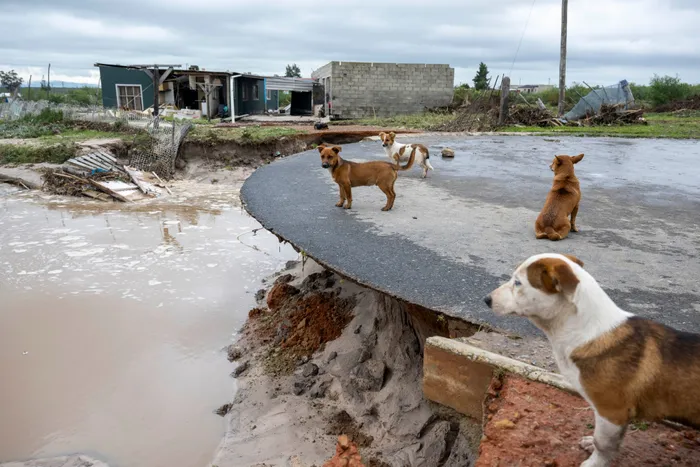Blame game over collapsed dam owners

Nicholas Snell’s home Snell’s home at 2 Roscovan Street suffered extensive damage when one side of the house collapsed during flooding in Riverlands due to failed dams. The water destroyed much of his property, leaving his oven, fridges, and kitchen cupboards strewn outside. Questions about who owned the dams are being asked. Picture: Henk Kruger/Independent Newspapers
Government departments have started passing the buck about the ownership of the Riverlands dams that collapsed, flooding the surrounding communities and leaving a trail of destruction with more than 100 people displaced.
Initially, three dams located on property known as Dassenberg in the Swartland Municipality breached on August 8, causing widespread severe floods to parts of the area. More than 100 residents have since been displaced and 14 people suffered minor injuries.
At the weekend, another flash flood was experienced, reportedly due to the work being done on the fourth dam.
The Swartland Municipality said that while the dams are located within the municipal borders of the City of Cape Town, they belong to the Department of Water and Sanitation (DWS).
However, the national department said it granted permission to the City to construct an emergency spillway on the fourth and remaining farm dam that was reported to be on a verge of collapse, to route the flood and lower the risk of failure of the dam.
“The three failed dams did not have sufficient spillways and had filled beyond the safe level, resulting in overtopping due to high rainfall and associated run-off, causing them to fail in series.
“The fourth dam, which is the highest dam in the valley, also has no spillway, and it has been discovered that it has some structural damage. The dams are owned by the Western Cape provincial government and serve the local farmers. The Department of Water and Sanitation is committed in conducting its regulatory function diligently, and depending on the outcomes of the investigation, those responsible for the failure of the three dams will be held accountable,” DWS said.
According to legislation, the custodian of a dam is responsible for maintenance and ensuring there is no danger posed to communities near it. Affected residents told the Cape Times this week that they were in the dark about the rebuilding process and have since established their own structure to ensure that the process is transparent.
Wouter Kriel, spokesperson for Local Government, Environmental Affairs and Development Planning MEC Anton Bredell, said the dams were situated on a farm belonging to the National Department of Rural Development and Land Reform.
“They purchased it in 2019 and are leasing it to a land reform beneficiary in terms of their Proactive Land Acquisition Strategy (PLAS) land reform strategy. They are the responsible owner.
After our reporting of three dams, it was found that there were in fact four dams.
The National Department of Water Sanitation, who is the authority responsible for dam registration and dam safety in South Africa (will know ownership),” said Kriel.
City of Cape Town Mayco member for Water and Sanitation Zahid Badroodien said their officials initially assisted with advice in response to the emergency by making consultants available.
“We did not implement any remedial measures, as the dams do not belong to the City. The National Department of Water and Sanitation was also involved in the dam safety aspects,” he said.
DWS was asked for clarity on the ownership of the dams and property.
The department's acting spokesperson, Andile Tshona, said: “There has been a lot of speculation about the owners of the four dams. The investigation instituted by Minister Pemmy Majodina will also cover that scope of ownership, including authorisation and compliance with Dam Safety Regulations.”
The Department of Rural Development and Land Reform did not respond to questions by deadline.
In a statement dated August 12, the department announced that Land Reform and Rural Development Minister Mzwanele Nyhontso was to visit the Dassenberg farm and the Riverlands community to assess the damage caused by the flooding.
“The flooding was caused by the failure of the wall of a dam located on the Dassenberg farm, which is under the ownership of the Department of Agriculture, Land Reform and Rural Development.
Dassenberg farm is currently leased by the department to a livestock farmer. The visit will afford the minister an opportunity to ascertain the extent of the damage and determine the type of intervention and support the department can initiate for the Dassenberg farm as well as the affected community of Riverlands,” read the statement.
Meanwhile, Agriculture, Economic Development and Tourism MEC Ivan Meyer handed over R14.98 million to the Citrusdal Water Users Association at the weekend to mitigate future flood damage to the Upper Olifants River catchment area.
The area was hard-hit by the 2023 and 2024 floods, with the farmland’s ecological infrastructure still damaged.
Cape Times